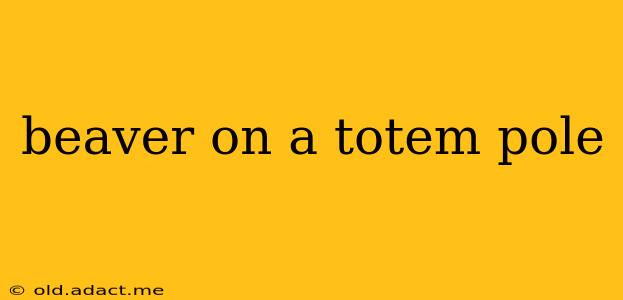The image of a beaver on a totem pole is far more than just a carved animal; it represents a rich tapestry of cultural significance, history, and symbolism deeply rooted in Indigenous traditions of the Pacific Northwest Coast. Understanding the meaning requires delving into the specific First Nations group responsible for its creation, as interpretations can vary subtly. However, some common themes emerge regarding the beaver's powerful presence on these iconic carvings.
What does a beaver symbolize?
The beaver's symbolism is multifaceted and often relates to its industrious nature and connection to water. For many Northwest Coast Indigenous peoples, the beaver represents:
-
Industry and resourcefulness: Beavers are known for their exceptional dam-building abilities, transforming landscapes and creating vital habitats. This industriousness translates into a totemic representation of hard work, ingenuity, and the ability to build and create. They are often associated with prosperity and abundance.
-
Water and survival: As aquatic mammals, beavers embody the vital resource of water, essential for life and sustenance. This connection symbolizes life-giving power, abundance, and the importance of respecting natural resources.
-
Transformation and adaptability: The beaver's ability to modify its environment reflects a capacity for adaptation and transformation, highlighting resilience and the power to overcome challenges.
-
Family and community: Beavers are highly social animals, living in family units and working collaboratively. This aspect of their behavior can symbolize family bonds, community spirit, and the importance of cooperation.
Why are beavers on totem poles?
The inclusion of a beaver on a totem pole is not arbitrary. It's a deliberate choice reflecting the animal's importance within the specific cultural context of the carving's creators. The meaning might depend on:
-
Clan affiliation: Certain clans or families may have a hereditary connection to the beaver, adopting it as a crest or symbol of their lineage.
-
Spiritual significance: Beavers might hold a specific spiritual meaning for a particular group, perhaps representing a guardian spirit or embodying particular virtues.
-
Historical events: A beaver might be incorporated to commemorate a significant event or ancestor associated with the animal or its attributes.
-
Geographical location: The prominence of beavers in a particular region might influence their presence on totem poles as a reflection of the local environment and its importance to the people.
What other animals are commonly found on totem poles?
While beavers hold a notable place, they are just one animal among many represented on totem poles. Other common animals include:
- Bears: Often symbolizing strength, power, and leadership.
- Eagles: Representing courage, vision, and spiritual power.
- Wolves: Symbolizing loyalty, intelligence, and protection.
- Salmon: Representing abundance, prosperity, and sustenance.
- Raven: Often a trickster figure, associated with knowledge and creativity.
How can I learn more about the specific meaning of a beaver on a particular totem pole?
To fully understand the meaning of a beaver on a specific totem pole, it's crucial to consider its origin. Researching the First Nation responsible for creating the pole is vital. Many museums and cultural centers dedicate themselves to preserving and interpreting Indigenous art and culture. Engaging with Indigenous communities directly, when appropriate and respectful, offers the most accurate and nuanced understanding of these powerful symbols. Remember, respecting Indigenous cultures and intellectual property is paramount.
Are there any myths or legends associated with beavers in Indigenous cultures?
Many Indigenous cultures hold rich oral traditions and stories featuring beavers. These stories often delve into the animal's character, highlighting its ingenuity, resourcefulness, and connection to the natural world. Unfortunately, these narratives are often passed down orally and may not be widely documented in written form. Respectful engagement with Indigenous communities can provide access to these fascinating stories.
In conclusion, the beaver on a totem pole is not simply a decorative element but a powerful symbol, carrying deep cultural and spiritual significance. Understanding its meaning requires sensitivity, respect, and a willingness to delve into the rich tapestry of Indigenous traditions of the Pacific Northwest Coast.
